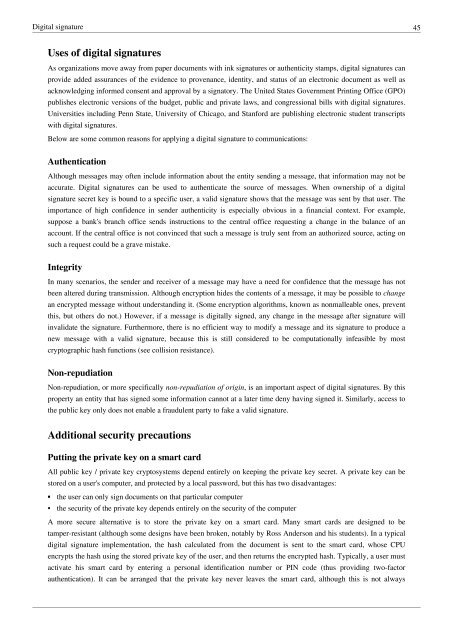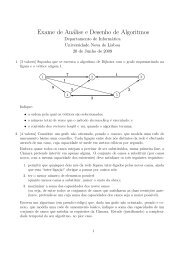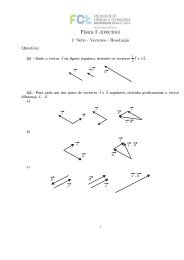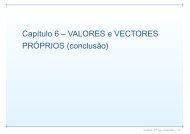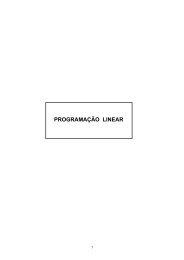Security Articles from Wikipedia
Security Articles from Wikipedia
Security Articles from Wikipedia
Create successful ePaper yourself
Turn your PDF publications into a flip-book with our unique Google optimized e-Paper software.
Digital signature 45<br />
Uses of digital signatures<br />
As organizations move away <strong>from</strong> paper documents with ink signatures or authenticity stamps, digital signatures can<br />
provide added assurances of the evidence to provenance, identity, and status of an electronic document as well as<br />
acknowledging informed consent and approval by a signatory. The United States Government Printing Office (GPO)<br />
publishes electronic versions of the budget, public and private laws, and congressional bills with digital signatures.<br />
Universities including Penn State, University of Chicago, and Stanford are publishing electronic student transcripts<br />
with digital signatures.<br />
Below are some common reasons for applying a digital signature to communications:<br />
Authentication<br />
Although messages may often include information about the entity sending a message, that information may not be<br />
accurate. Digital signatures can be used to authenticate the source of messages. When ownership of a digital<br />
signature secret key is bound to a specific user, a valid signature shows that the message was sent by that user. The<br />
importance of high confidence in sender authenticity is especially obvious in a financial context. For example,<br />
suppose a bank's branch office sends instructions to the central office requesting a change in the balance of an<br />
account. If the central office is not convinced that such a message is truly sent <strong>from</strong> an authorized source, acting on<br />
such a request could be a grave mistake.<br />
Integrity<br />
In many scenarios, the sender and receiver of a message may have a need for confidence that the message has not<br />
been altered during transmission. Although encryption hides the contents of a message, it may be possible to change<br />
an encrypted message without understanding it. (Some encryption algorithms, known as nonmalleable ones, prevent<br />
this, but others do not.) However, if a message is digitally signed, any change in the message after signature will<br />
invalidate the signature. Furthermore, there is no efficient way to modify a message and its signature to produce a<br />
new message with a valid signature, because this is still considered to be computationally infeasible by most<br />
cryptographic hash functions (see collision resistance).<br />
Non-repudiation<br />
Non-repudiation, or more specifically non-repudiation of origin, is an important aspect of digital signatures. By this<br />
property an entity that has signed some information cannot at a later time deny having signed it. Similarly, access to<br />
the public key only does not enable a fraudulent party to fake a valid signature.<br />
Additional security precautions<br />
Putting the private key on a smart card<br />
All public key / private key cryptosystems depend entirely on keeping the private key secret. A private key can be<br />
stored on a user's computer, and protected by a local password, but this has two disadvantages:<br />
• the user can only sign documents on that particular computer<br />
• the security of the private key depends entirely on the security of the computer<br />
A more secure alternative is to store the private key on a smart card. Many smart cards are designed to be<br />
tamper-resistant (although some designs have been broken, notably by Ross Anderson and his students). In a typical<br />
digital signature implementation, the hash calculated <strong>from</strong> the document is sent to the smart card, whose CPU<br />
encrypts the hash using the stored private key of the user, and then returns the encrypted hash. Typically, a user must<br />
activate his smart card by entering a personal identification number or PIN code (thus providing two-factor<br />
authentication). It can be arranged that the private key never leaves the smart card, although this is not always


